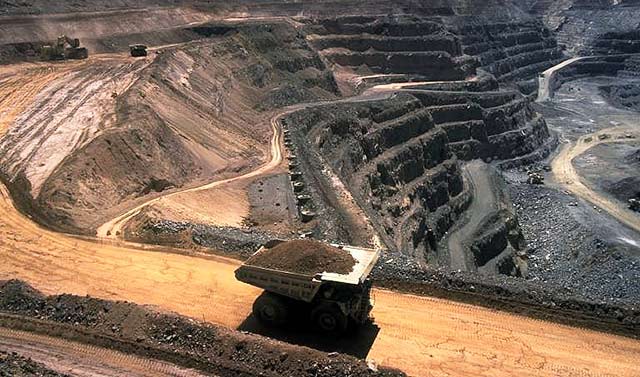Kautilya’s Arthasastra, written some 2000 years ago, reveals that a system of mining: private and public sector ownership, payment of royalty and stern punishment for illegal mining existed in those days. As on date, we have not progressed very far; excepting that the legislations enacted have become restrictive and cumbersome.
Odisha is decidedly one of the richest mineral bearing States of the country. It is also a fact that the State has not taken full advantage of its enormous mineral potential. As a result, it has remained comparatively undeveloped. Odisha’s bane has been lack of vision, determined will by the political class and administration, anti-development approach by some of the self- vested NGOs and violent activities of the Maoists. The State cannot develop unless the fixed mindset is changed and imitational activities are firmly curbed. However, I would like to record one notable exception to my statement…… “lack of vision”, The exception is attributed to late Biju Patnaik who established a modern port at Paradip, without rail connectivity, power supply and with a ramshackle, road: This is unprecedented in the annals of port development. The other project worthy of highlighting is construction of 150km long Expressway connecting Daitari iron ore mine with Paradip port. Expressway was totally a new concept in India. The other visionary of the state is Dr. Bansidhar Panda, founder and Chairman of IMFA Group who set up a Ferroalloys complex at Theruvali and subsequently at Choudwar.
Before I deliberate on the status and needs of the mineral sector, one must understand certain basic facts about minerals and mining. Minerals have been formed millions of years ago Minerals can be mined where they occur and cannot be replenished Earliest authentic record of mining in India is revealed from Kautilya’s Arthasastra, written some 2000 years ago. It is clearly established that during that period, there existed a system of mining, private and public sector ownership payment of royalty and stern punishment for illegal mining. We have not progressed very far since excepting that the legislations enacted have become restrictive and cumbersome.
Milestones in Mineral Exploration
At this point, I would like to highlight the pioneering efforts of the officers of Geological Survey of India, State Directorate of Mining & Geology, CMPDI and TISCO which resulted in significant discoveries and substantial increase in the quantum of reserves of minerals and ores in the State: Two examples are worthy of special mention. The first is East- Coast Bauxite Project, jointly executed by GSI, DM & G and MECL, during 1976-78, It was a crash programme of exploration unprecedented in the annals of mineral investigation in the country. Mineral inventory of 1971 by IBM indicated a reserve of 15 million tonnes in Orissa. The ECB Project resulted in increase of reserves by as much as 100 times to 1,529 million tonnes. Now it stands at 1800 million tonnes. Orissa accounts for approx 55% of the total reserves of the country. The second example relates to chromite. Here again, an integrated programme of proving jointly implemented by GSI, DM & G and MECL with inputs by OMC and Tata Steel during 1976-82 resulted in almost 100 fold increase in reserves from IB to 173 million tonnes. Odisha accounts for 95% of the total reserves of the country. Besides above two, there has been significant addition to the resources of Iron ore in Daitari Iron ore Mines of OMC. The reserves estimated by the Directorate of Mining and Geology and IBM during 1958-1962 where of the order of 50 million tonnes at 62% Fe cut off. Since mining started in 1967 about 30 million tonnes of iron ore have been extracted. Now the resources estimated as on 01.04.2014 stand at 178 million tonnes. This is a remarkable step up, made possible by lowering the cut off and proving the presence of ore at deeper levels.
The other minerals in which the State is the leader in terms of reserves and production are beach sand minerals, Coal, Iron ore and Manganese ore.
The ores of strategic importance which the State possesses are Nickel and Platinum Group of Metals (PGM) and Vanadium bearing magnetite Besides, there are positive indications about occurrences of Diamond, Tin ore, Gold, Base metals, Kyanite and coloured Gemstones. While limestone and dolomite are being mined in large scale, production of Graphite, Fireclay, China clay have been of late staggered
Two other significant developments are worthy of note. These are UNDP Project for development of Gemstone resources and High Resolution Aeromagnetic and Radiometric Survey. The important outcome of these prestigious projects are establishment of a Gem Testing laboratory, Data Processing Centre for processing and interpretation of aeromagnetic data and training of officers of DM & G and OMC abroad.
Legislative Provisions and Mineral Administration
The main legislative provisions that administer, govern and regulate mining operations are the following,
- The Mines & Minerals (Development & Regulation) Act, 1957
- The Mines Act, 1952
- The Forest (Conservation) Act, 1980
- The Environment (Protection) Act, 1986
The mining industry in the states of Karnataka, Goa, Odisha and Jharkhand and particularly iron ore suffered a serious setback when reports of illegal mining and trading came to limelight. This prompted Central Government to appoint a Commission of Inquiry consisting of Justice M.B. Shah retired Judge of Supreme Court to inquire into the allegations and incidence of mining iron and manganese ore in contravention of MMDR, Act, 1957, Forest (conservation) Act, 1980, Environment (Protection) Act, 1986, and other Central and State Acts and Rules. The Commission visited the mines and held detailed discussion with officials of the State and Central Governments, mine owners, FIMI, SGAT and other stakeholders and submitted its report in 2013. Following the recommendations of the Commission, CEC and orders of the Apex Court, a large number of iron and manganese ore mines were closed down. Fate of a number of closed mines is still awaiting orders of the Supreme court. In the meantime, several closed mines have opened with orders of the Apex Court.
Following the recommendations of Shah Commission, observations of CEC and Apex Court, the State government has taken a number of steps to streamline the mineral administration through IT, mineral transport DGPS survey and demarcation of lease areas, tracking of ore carrying trucks by GPS, issuance of permits, trip sheets, Dealer Licenses online, introduction of Integrated Mines and Minerals Management System, installation of electronic weighbridges, registration of ore carrying trucks, increasing surveillance by Enforcement squads, review by State Level Task force. All such initiatives have resulted in significant decrease in illegal mining, transport and trading.
In the meantime, MMDR Act has been amended in 2015. The most important provisions in the Amended Act are Auction of Mineral bearing Areas and Creation of District Mineral foundation, Subsequently, in a Notification issued by Ministry of Mines, 31 minerals which hitherto were classified as Major Minerals will be treated as Minor Minerals, Consequently grant of quarrying rights and administration for all these minerals will hereafter will be the exclusive domain of the State Government.
The total area held under mining leases in the State is about 800 sq.kms. which work out to a mere 0.007% of the total area of the State. Therefore it should be quite possible to administer and regulate mining activities over such a small area in the State effectively in conformity with all statutory provisions.
Export
Iron ore and chromite constitute two most important mineral commodities of export from Odisha. Export of iron ore from India reached a peak of 117 million tonnes with Odisha contributing 12.2 million tonnes through Paradip port during the year 2009-10. The country’s export fell to an all time low of 6 million tonnes during 2014-15 and export from Paradip port recorded a historical low figure of 0.9 million tonnes. Export price has fallen from a level of $80/ DMT to less than $ 50/DMT for 62% Fe grade ore. Iron ore major like Rio Tinto, BHP Billiton and Vale have been flooding the iron ore market with India looking on hopelessly. The main reasons for sharp decline are the following:
- Slowdown in the economy of China, closure of several iron and steel plants and consequent decrease in quantum of import and landed price.
- Government of India continuing to levy 30% export duty
- High railway freight of iron ore transported for export.
Export of iron ore is imperative for utilizing the infrastructure created by developing port, railway and road facilities at huge investment. The least GOI can do to alleviate the situation is withdrawal of export duly and rationalization of railway freight structure.
In the budget for 2016-17 presented by the Union Finance Minister, export duty on iron ore containing less than 58% Fe has been withdrawn. But it will not bring any relief to the prospect of export from Odisha as the grades of iron ore exported range between 60-65% Fe.
In regard to export of chromite, the figure for 2011-12 was 3,22,750 tonnes. It slumped to 27,500 tones during 2014-15. The reasons being sharp fall in demand, high export duty (from Rs 2,000/t to 30% fobt price) and sharp decrease in export price from over $ 250/t-fobt to $ 130 and non-availability of buyers.
In the budget for 2016-17, export duty on chrome ore has been totally withdrawn.
Aluminium industry in India is in distress owing to lower demand, higher, cheaper imports and continuous fall in international prices. Increase in import duty on Aluminium would to some extent provide relief to the domestic industry.
Mineral Policy
Following the amendment to the MMDR Act in 2015, GOI should have come up with a comprehensive new National Mineral Policy, the last one being NMP 2008. Instead, Policies and Guidelines are being notified piecemeal.
As regard Odisha, it is the only State which has not framed a Mineral Policy yet.
The State Government has framed a Mineral Exploration Policy and created an Exploration Corporation. In my view, creation of a separate Exploration Corporation as a subsidiary of OMC is not warranted as the objective could be best served by strengthening Directorate of Geology and OMC.
Mere Creation of new Corporation/ institution does not help. Another case is creation of a Directorate of Steel.
Mining Revenue
Royalty constitutes the main source of mining revenue to the Sate exchequer, With increase in rates of royalty for iron ore and chromite to 15% of average sale price, Rs 80/t for, limestone and Rs 75/t for Dolomite w.e.f 01.09.2014 one would expect significant increase in royalty collection. But this did not materialize due to
- Closure of a number of mines
- Lack in demand both in export and domestic fronts coupled with low price
Royalty earning during 2015-16 is expected to be around Rs 5.500 crores.
District Mineral Foundation
Payment by lessees to DMF will vary between 30% and 10% of royalty depending on whether the lease is granted before 12 January 2015 or after. Take the example of Keonjhar district which presently contributes around Rs 2100 crore by way of royalty, Contribution to DMF by the lessees may amount to Rs 600 crores annually and this will not be an one-time contribution. Flow of the contribution to DMF will increase year after year. This will be huge fund, proper utilization of which calls for vision, meticulous planning and execution under expert advice. Similar situation will arise in other mineral rich districts of the State.
Environment Management
While environment management in the leasehold areas is the responsibility of the lessees, environment management in mining regions is the responsibility of the State administration. Odisha is the first State where EIA studies and formulation of EMP had been done in two major mining regions, namely Joda-Barbil and Sukinda by the Directorate of Mining & Geology through reputed consultants. This exercise should be taken to cover all the mining regions of the State including the two studied almost 3 decades ago.
The approach should be formulate and implement EMP for short term and long term. The focus should be
- cleaning up of water bodies and keeping them pollution free
- provision of check dams to prevent spillage of waste and effluents from mines to water bodies
- provision of water harvesting structures
- raise plantation and increase forest cover
- provision of hygienic toilets in each house hold
- prevent erosion of top soil
- provision for bathing ghats, washing of vehicles
- provision to prevent pollution of air by using water sprinklers on haul roads, dust extractors
- provision of alternate energy source like solar
- environment education
Funds needed for consultancy services and providing common facilities can be obtained from DMF.
Infrastructure
Odisha is having two well-developed major ports at Paradip and Dhamra. With Gopalpur fast developing, there would be enough capacity to handle mineral cargo till at least 2025
Railways have limited kitty. Whatever they are providing for mineral traffic may not be adequate but I would urge for completion of the ongoing projects. Besides for long term development, the following links merit consideration;
- Jeypore-Malkangiri
- Badampahar-Keonjhargarh
- Barbil-Rangra/ Roxy
- Tomka-Sukinda Road
The Railway budget for 2016-17 provides provision of funds for construction of Jeypore-Malkanagiri rail link and additional funds for construction of ongoing railway projects.
In regard to road connectivity, NH 215 is eluding completion far too long.
As regards medical facilities, while there is strong justification of setting up of medical college at Keonjhar, facilities available in the District and sub-Divisional hospitals call for substantial improvement. The Cess hospital at Joda is in a very poor shape and needs special attention of the Ministry of Labour.
In the meantime, announcement has been made by the Chief Minister, Odisha that a medical college will be set up at Keonjhargarh.
Mineral based Industries
While I do not propose to deliberate on mineral based industries, I will like to point out three major failures these are
- Mittal’s shying away from setting up a mega iron and steel complex in Keonjhar district
- Likely exit of S. Korea’s steel major POSCO
- Non-availability of Bauxite for Vedanta’s alumina refinery at Lanjigarh
I would like to highlight the possibility of extracting nickel and cobalt from the overburden of chromite mines in Sukinda valley. The quantity available is in excess of 9 million tonnes of average 0.6% nickel. R & D tests carried out by IMMT have established the technical feasibility of extracting nickel and cobalt. As India is net importer of nickel metal, it is necessary that both the State & Central Govt. take the initiative of setting up of facilities for extracting nickel and cobalt in Sukinda area.
Vision Document Make in India
At the instance of the State Government Society of Geoscientists and Allied Technologists (SGAT) had prepared two documents-
- Blueprint of Mineral Development in Orissa during the Decennium 1997-2007- August 1997
- Vision Document on Mineral Development in Odisha (May 2009)
I regret to record that like many of the reports and documents, the recommendations made in these two documents have not been given due consideration.
The State Government has now decided to make a Vision Document-2030. The Ruling Party (BJD) has decided to prepare a Vision Document-2036. In the Make in India conclave held in Mumbai in February 2016, the State Government made an announcement about its Vision for Development and Investment opportunities in the non-mineral sector.
The State Steel & Mines Department has initiated action for preparing a Vision Document-2030 for the mineral sector.
What is needed- we must set our priority first for short term (5 years) which we can implement and see the results.
Budgetary Provision
The dismal fund provision in the budget for the Steel & Mines Department (less than 0.1% of the total State budget) year after year will not permit even the routine activities of exploration, mineral administration assessment and collection of royalty, inspection of mines and prevention of illegal mining. There is urgent need to augment provision of fund so that the much needed development programme like environment management, infrastructure development, peripheral development, mineral economics, R & D, modernization of laboratory facilities and training of technical manpower can be taken up.
Epilogue
I have recorded some random thoughts about mineral development scenario and needs of the State.
We have crossed a span of 59 years since out country gained independence. Within much less period, other countries have made rapid strides in all fields- health, education, national income, industry, export earnings, defence and attracting FDI. We are still struggling to set our basics and priorities.
The Mineral Industry is beset with numerous problems- plethora of laws and procedures, poor infrastructure, high power tariff, unproductive labour, retrograde unionism, high level of taxation, high product cost and negativism. There is lack of accountability at all levels.
Let it be realised that if Odisha has to develop fast, it has to be through judicious exploitation of mineral resources. Let the NGOs, political class and all other stakeholders allow this to happen for benefit of the State and for a change, let the mining industry take a proactive stance.









































